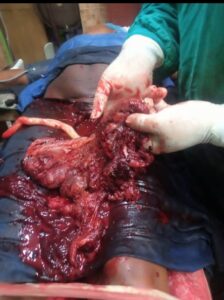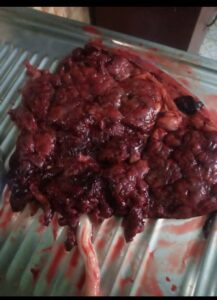
ALTH

ALTH
“`PLACENTA ACCRETA“`
CAUSES, SYMPTOMS, COMPLICATION AND MANAGEMENT
WHAT IS PLACENTA ACCRETA?
Placenta accreta is a serious pregnancy condition that occurs when the placenta grows too deeply into the uterine wall.
Typically, the placenta detaches from the uterine wall after childbirth. With placenta accreta, part or all of the placenta remains attached. This can cause severe blood loss after delivery.
It’s also possible for the placenta to invade the muscles of the uterus (placenta increta) or grow through the uterine wall (placenta percreta).
Placenta accreta is considered a high-risk pregnancy complication. If the condition is diagnosed during pregnancy, you’ll likely need an early C-section delivery followed by the surgical removal of your uterus (hysterectomy).
WHAT ARE THE SYMPTOMS?
Placenta accreta often causes no signs or symptoms during pregnancy — although vaginal bleeding during the third trimester might occur.
Occasionally, placenta accreta is detected during a routine ultrasound.
WHAT ARE THE CAUSES?
Placenta accreta is thought to be related to abnormalities in the lining of the uterus, typically due to scarring after a C-section or other uterine surgery. Sometimes, however, placenta accreta occurs without a history of uterine surgery.
WHAT ARE THE RISK FACTORS?
Many factors can increase the risk of placenta accreta, including:
*Previous uterine surgery*. The risk of placenta accreta increases with the number of C-sections or other uterine surgeries you’ve had.
*Placenta position*. If the placenta partially or totally covers your cervix (placenta previa) or sits in the lower portion of your uterus, you’re at increased risk of placenta accreta.
*Maternal age*. Placenta accreta is more common in women older than 35.
*Previous childbirth*. The risk of placenta accreta increases as your number of pregnancies increases.

ALTH
WHAT ARE THE COMPLICATIONS?
Placenta accreta can cause:
√ *Heavy vaginal bleeding*. Placenta accreta poses a major risk of severe vaginal bleeding (hemorrhage) after delivery. The bleeding can cause a life-threatening condition that prevents your blood from clotting normally (disseminated intravascular coagulopathy), as well as lung failure (adult respiratory distress syndrome) and kidney failure. A blood transfusion will likely be necessary.
√ *Premature birth*. Placenta accreta might cause labor to begin early. If placenta accreta causes bleeding during your pregnancy, you might need to deliver your baby early. Visit our medical professional at Adebayo Living Tower Hospital.

ALTH
DOES PLACENTA ACCRETA HARM THE BABY?
Placenta occurs when the placenta-the organ that provides nutrients and other support to a developing festus- attached too deeply to the uterine wall.
This is a serious condition that can cause complications for the baby and mother, especially during the delivery.
WHAT ARE THE TYPES OF PLACENTA ACCRETA?
Placenta accreta is the general term to describe this condition, but there are three specific types of this condition:
*Placenta accreta*. The placenta firmly attaches to the wall of the uterus, but does not pass through the wall or impact the muscular wall of the uterus.
*Placenta increta*. The placenta is more deeply embedded in the wall of the uterus and also firmly attaches to the muscular wall of the uterus.
*Placenta percreta*. The placenta extends through the wall of the uterus and muscles and, in some cases, attaches to other nearby organs such as the bladder or intestines.
OUR DIAGNOSIS ON PLACENTA ACCRETA AT ADEBAYO LIVING TOWER HOSPITAL
If you have risk factors for placenta accreta during pregnancy — such as the placenta partially or totally covering the cervix (placenta previa) or a previous uterine surgery — our medical professional at adebayo living tower Hospital will carefully examine the implantation of your baby’s placenta.
Through an ultrasound or MRI, our medical professional at adebayo living tower hospital can evaluate how deeply the placenta is implanted in your uterine wall.
 ALTH
ALTH
ALTH
“`I …C …T Department“`
*ADEBAYO LIVING TOWER HOSPITAL*
ALTH

Recent Comments